AMD’s GTX 560 Ti Counter-Offensive: Radeon HD 6950 1GB & XFX’s Radeon HD 6870 Black Edition
by Ryan Smith on January 25, 2011 12:20 PM ESTThe Test & Gaming Performance
For our testing we are using both AMD and NVIDIA’s latest drivers where suitable. For AMD this means the 11.1a Hotfix, and for NVIDIA this means the 266.58 drivers for the GTX 400 and 500 series, 266.56 for the new GTX 560 Ti, and 262.99 for the GTX 200 series. Compared to our previous benchmarks NVIDIA Civilization V performance is way up, and SmallLuxGPU performance is up for both AMD and NVIDIA. There are no significant performance improvements elsewhere.
For NVIDIA cards all tests were done with default driver settings unless otherwise noted. As for AMD cards, we are disabling their new AMD Optimized tessellation setting in favor of using application settings (note that this doesn’t actually have a performance impact at this time), everything else is default unless otherwise noted.
| CPU: | Intel Core i7-920 @ 3.33GHz |
| Motherboard: | Asus Rampage II Extreme |
| Chipset Drivers: | Intel 9.1.1.1015 (Intel) |
| Hard Disk: | OCZ Summit (120GB) |
| Memory: | Patriot Viper DDR3-1333 3 x 2GB (7-7-7-20) |
| Video Cards: |
AMD Radeon HD 6970 AMD Radeon HD 6950 2GB AMD Radeon HD 6950 1GB AMD Radeon HD 6870 AMD Radeon HD 6850 AMD Radeon HD 5970 AMD Radeon HD 5870 AMD Radeon HD 5850 AMD Radeon HD 5770 AMD Radeon HD 4870 NVIDIA GeForce GTX 580 NVIDIA GeForce GTX 570 NVIDIA GeForce GTX 560 Ti NVIDIA GeForce GTX 480 NVIDIA GeForce GTX 470 NVIDIA GeForce GTX 460 1GB NVIDIA GeForce GTX 460 768MB NVIDIA GeForce GTS 450 NVIDIA GeForce GTX 285 NVIDIA GeForce GTX 260 Core 216 |
| Video Drivers: |
NVIDIA ForceWare 262.99 NVIDIA ForceWare 266.56 Beta NVIDIA ForceWare 266.58 AMD Catalyst 10.10e AMD Catalyst 11.1a Hotfix |
| OS: | Windows 7 Ultimate 64-bit |
For our look at gaming performance we’re going to skip our running commentary at this time. In practice the 1GB 6950 is just as fast as the 2GB 6950 at 1920x1200 and 1680x1050 – the essential resolutions for a $260 card. It’s only at 2560x1600 and Eyefinity resolutions that the 2GB card makes a difference with most games at this time. This is likely to change in the near future, but for the time being –and as you’ll see – there’s little disadvantage to a 1GB 6950 right now.
Meanwhile we’re also including the XFX Radeon HD 6870 Black Edition in these charts. In general it’s around 5% faster than a stock-clocked 6870, which isn’t enough to cut in to the GTX 560 Ti’s 10-15% lead. At $20 less than the GTX 560 Ti this makes it a potential value spoiler, but not a direct competitor.
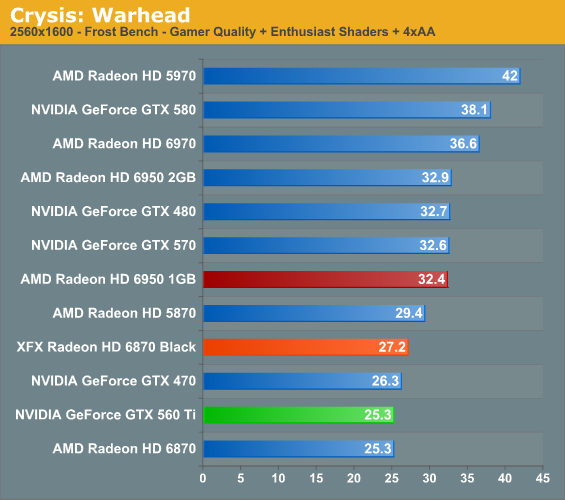
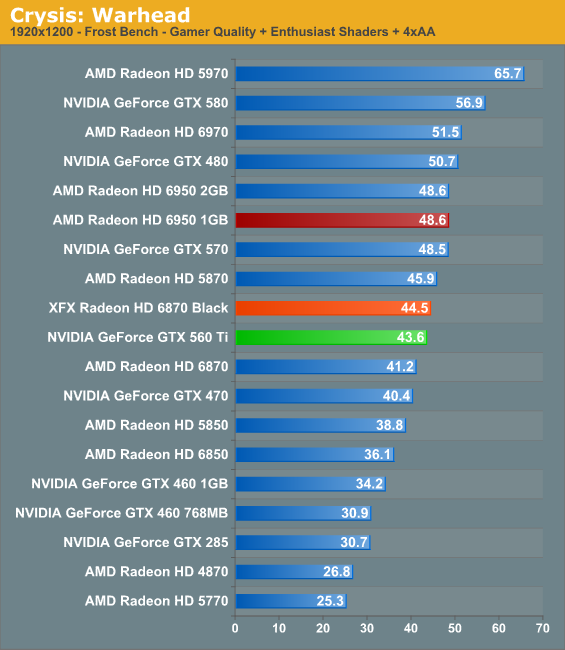
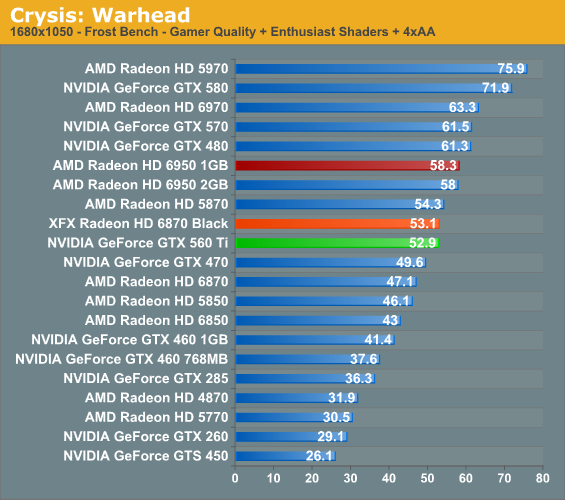
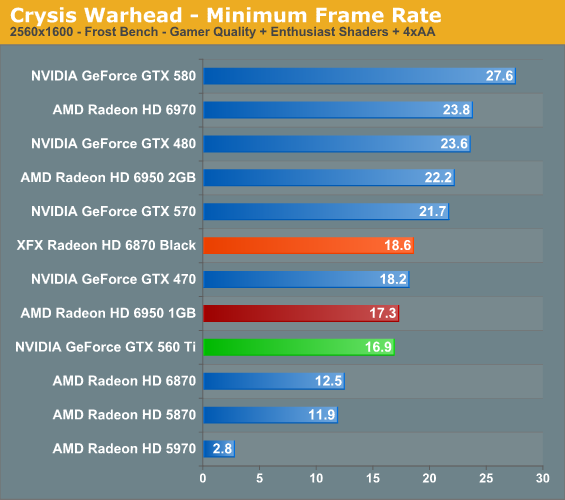
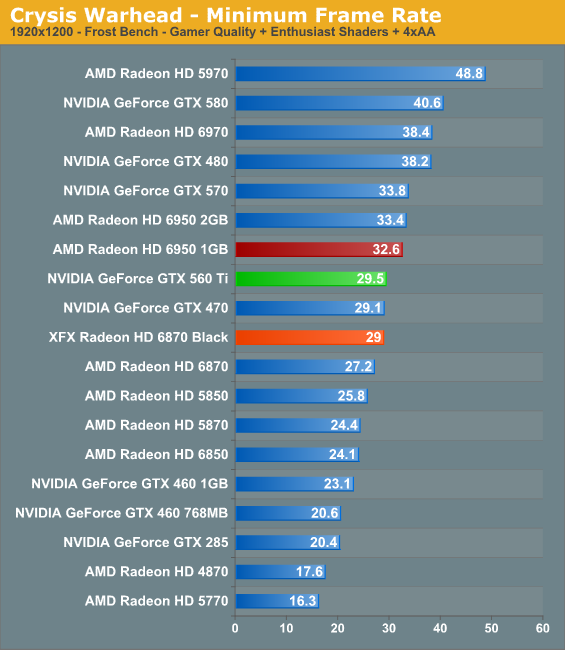
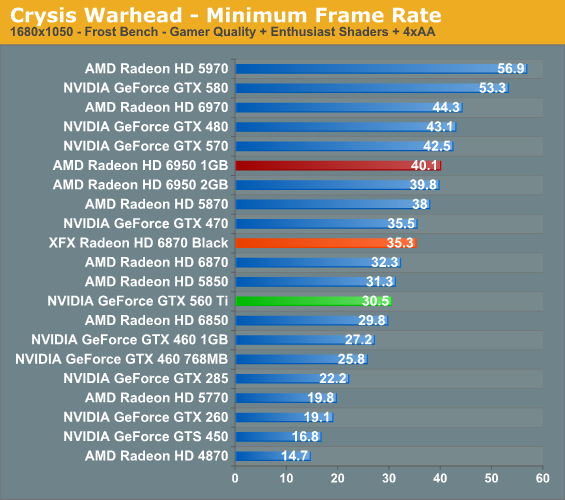

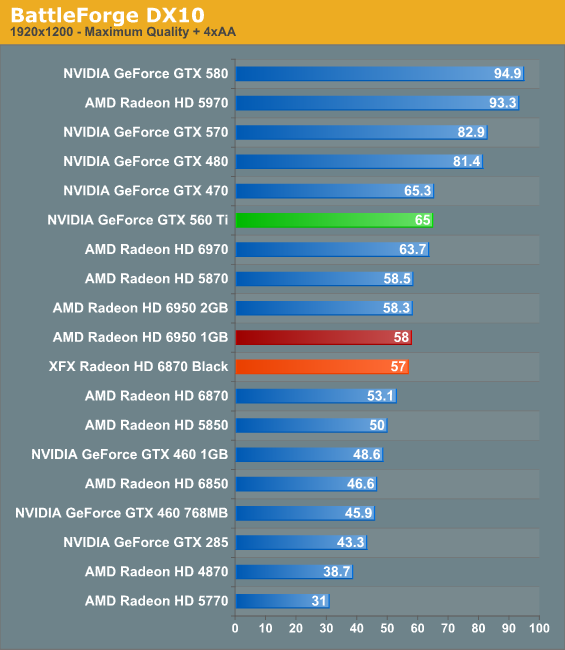
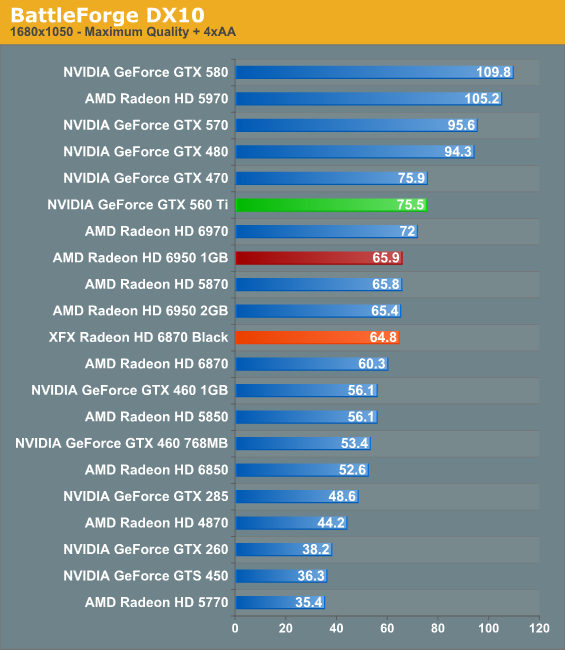

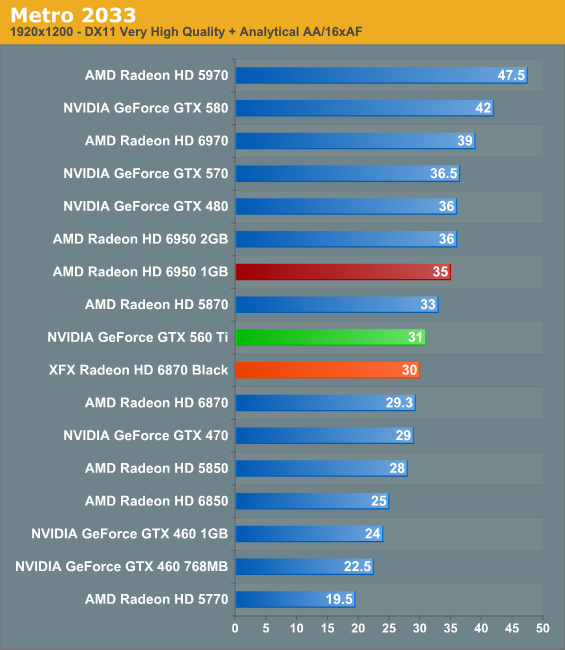
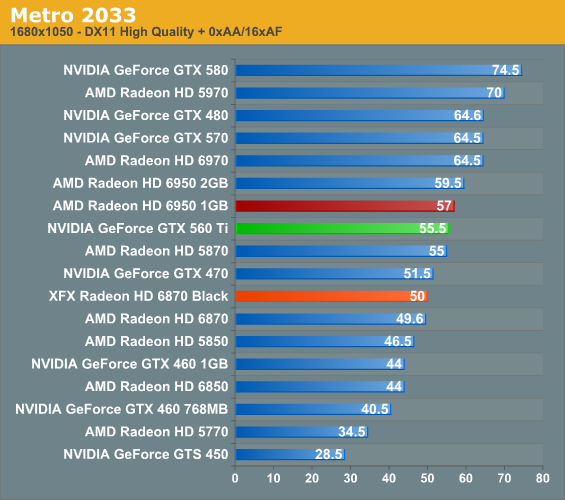
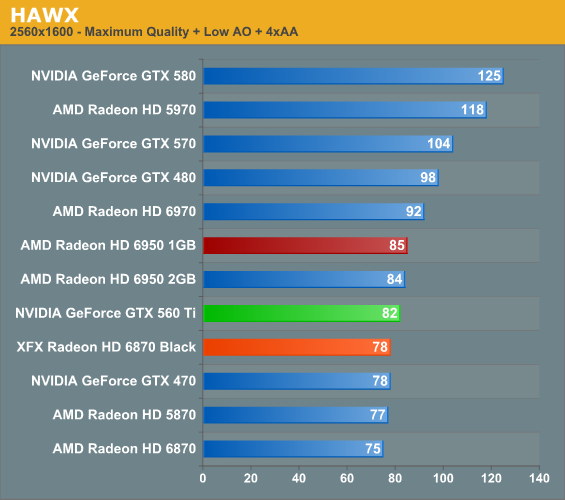
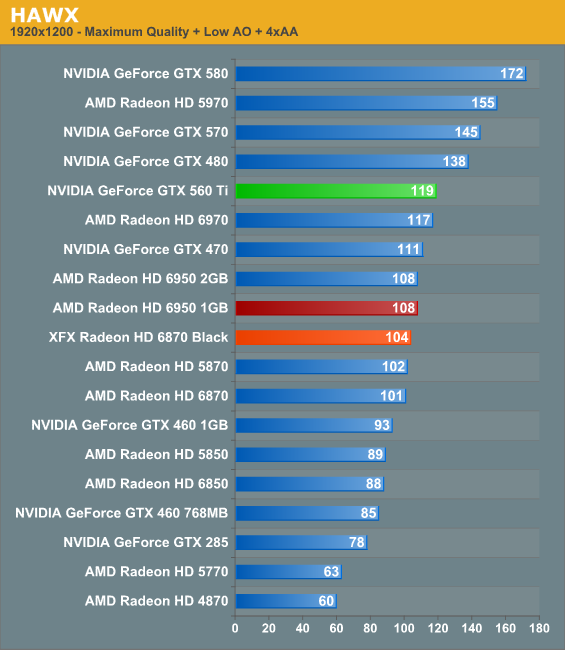
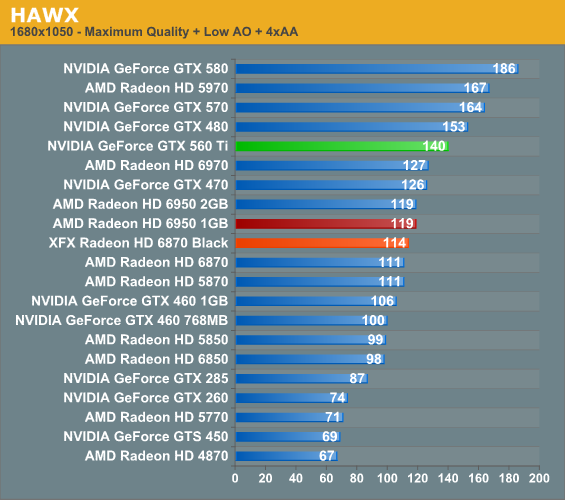
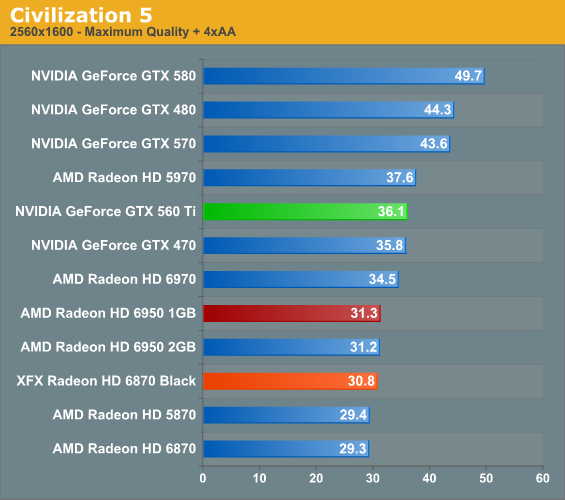
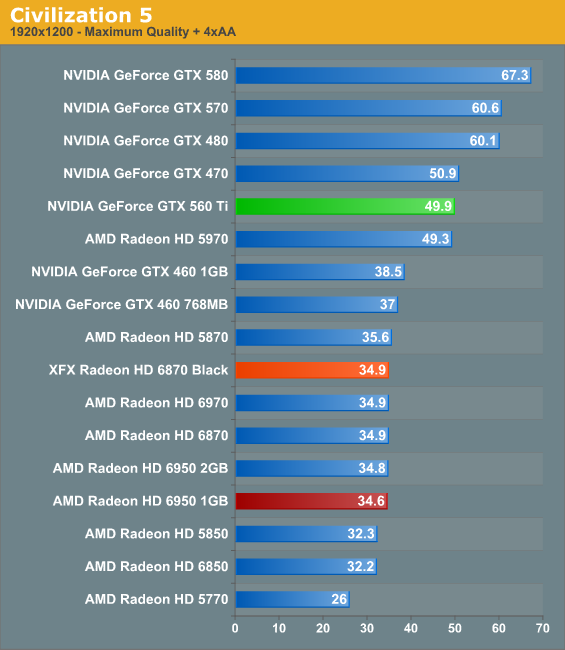
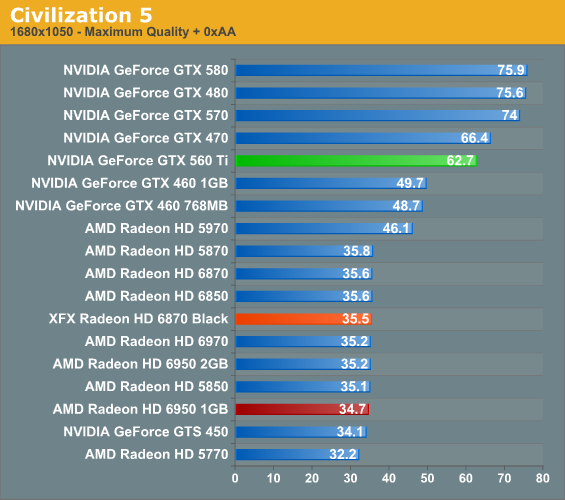
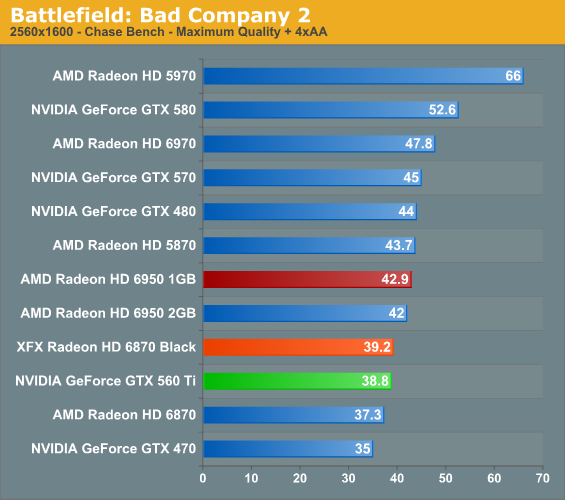
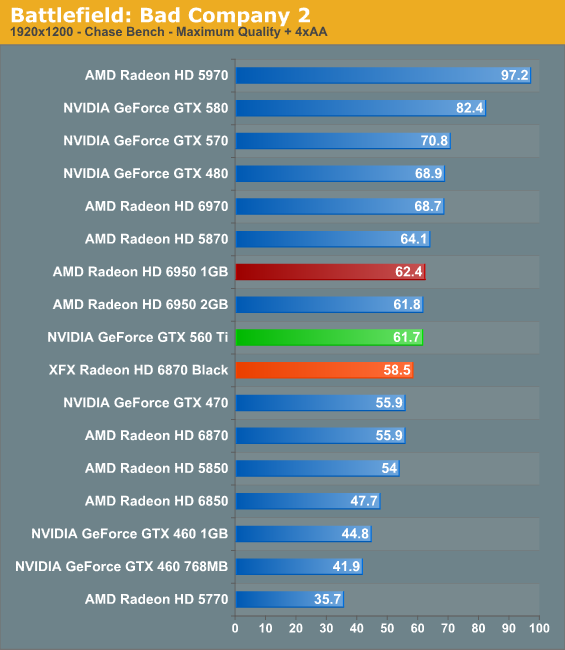
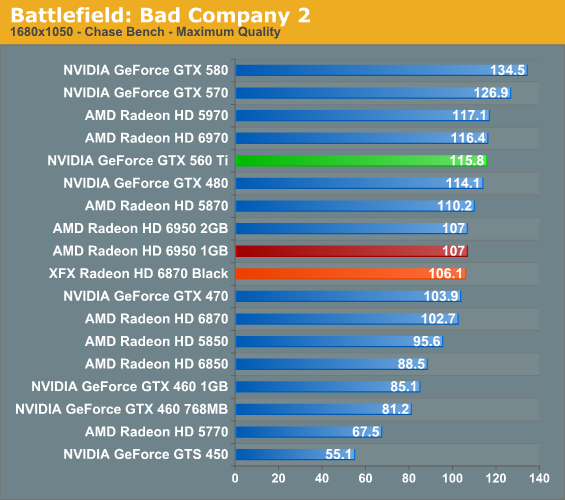
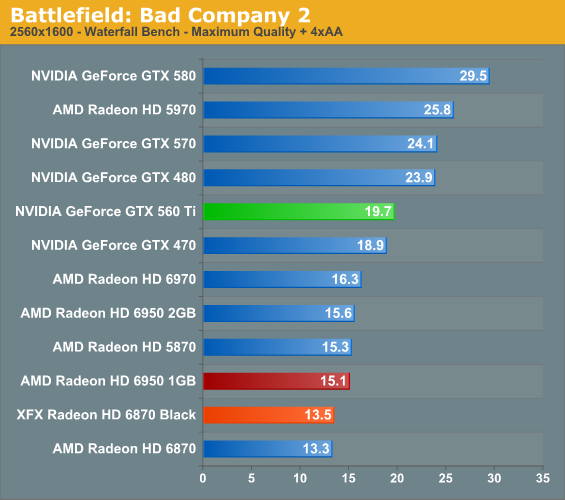

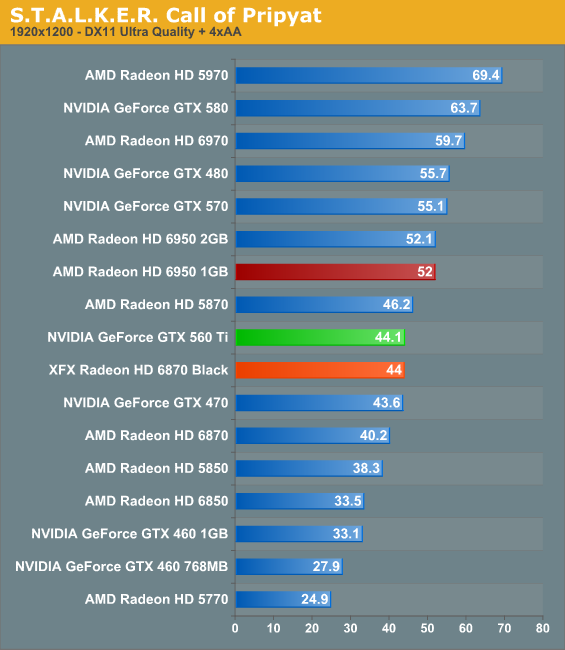
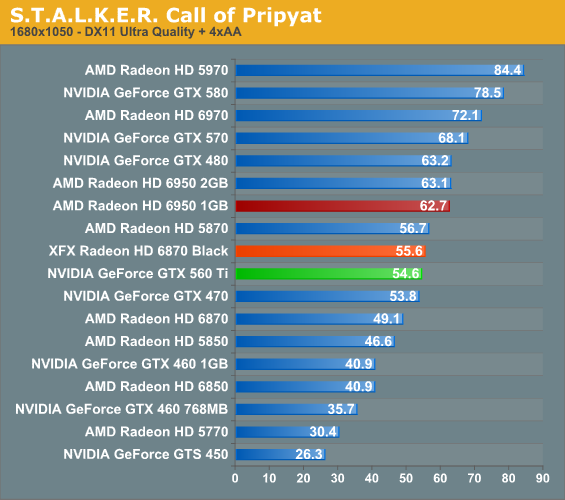
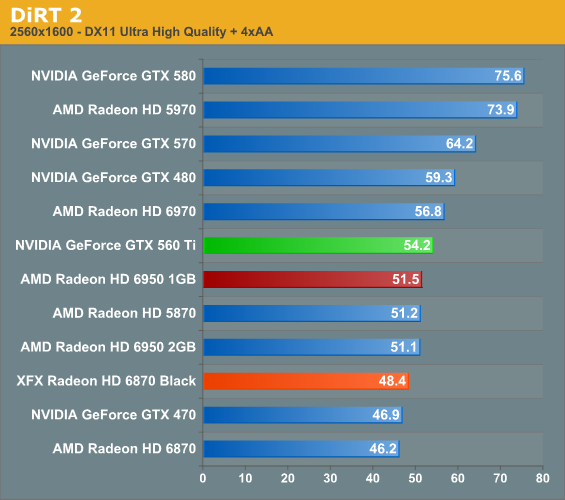
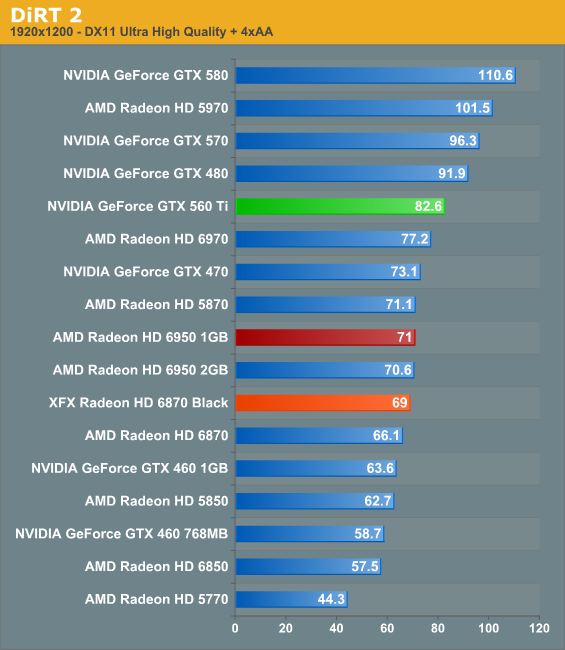

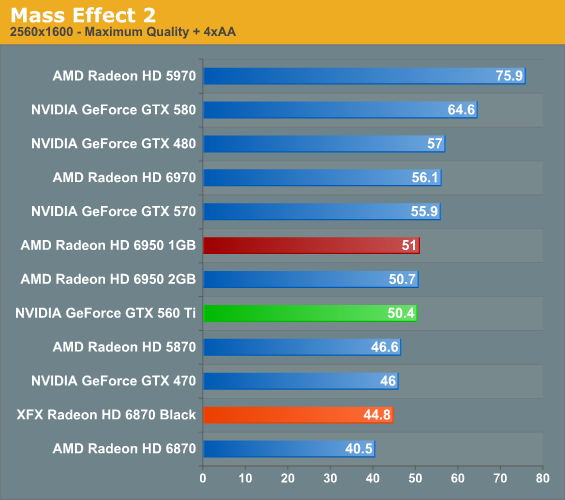
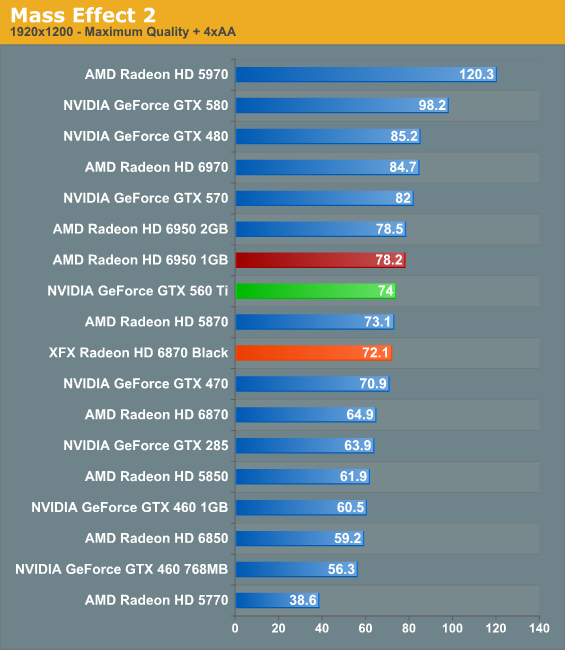
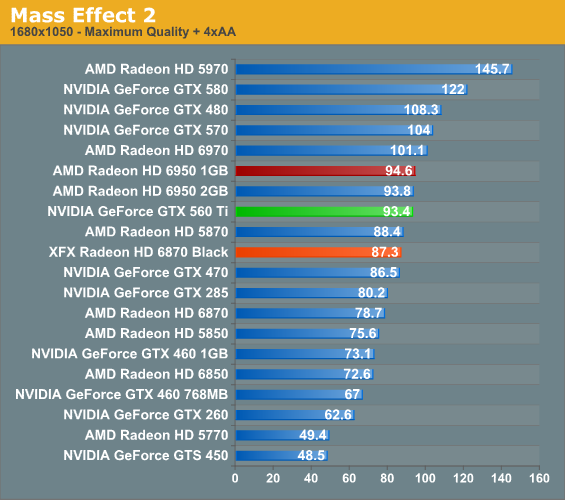




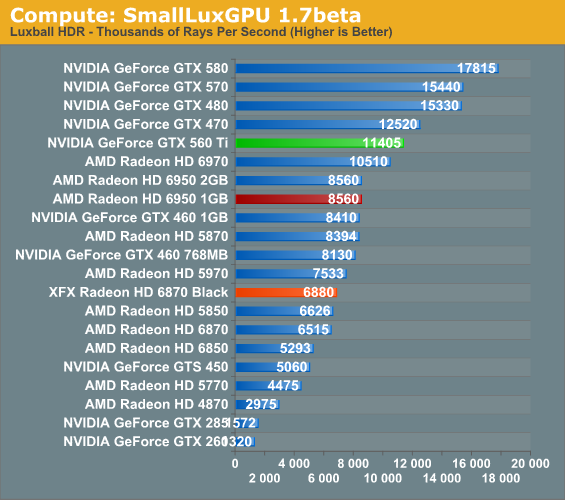










111 Comments
View All Comments
Stuka87 - Tuesday, January 25, 2011 - link
Why does every single ATI card get the EXACT same FPS in Civilization 5? Did the company that made it get paid off by nVidia to put a frame cap on ATI cards or what? It makes zero sense that 2 year old ATI cards would get the same FPS as just released ATI cards.So... What gives?
Ryan Smith - Tuesday, January 25, 2011 - link
Under normal circumstances it's CPU limited; apparently at the driver level. Just recently NVIDIA managed to resolve that issue in their drivers, which is why their Civ 5 scores have shot up while AMD's have not.Stuka87 - Wednesday, January 26, 2011 - link
Hmm, interesting.WhatsTheDifference - Wednesday, January 26, 2011 - link
please forgive me, Ryan, as I know this sounds abrasive and a little too off-topic from your response here. but speaking of 'score', what's the absolutely mind-boggling delay with including the 4890. quite frankly, if even one of any performance test over the relevant life of the 285 had not the 285 in it, nvidia would burn this site to the ground right after your nvidia-supporting readers did some leveling of their own. so honestly, for every 2xx series that finds its way into a benchmark, where in the world is ATI's top pick of that generation? site regs have posted about anandtech's nvidia-leaning ways, say, a few times, and this particularly clear evidence rather deserves an explanation - in my opinion. or, my spotty attendance contributed to missing at least one fascinating story.7Enigma - Wednesday, January 26, 2011 - link
4870 has been in most of the tests (see launch article) which can be used as a slightly lower-performing card. Use that as a guide.erple2 - Thursday, January 27, 2011 - link
I agree with 7Enigma - the difference between the 4870 and 4890 are no longer significant enough to warrant inclusion in the comparison. I seem to recall that the performance of the 4890 was between the 4870 (shown) and the nvidia 285 (also shown). Couple that with the relative trouncing 30%+ increase in performance) that the newer cards deliver to the GTX285, plus that the frame rates of the GTX285 isn't that high (+30% of 20 fps is 26 fps, which is still "too slow to make it relevant"), I'm not sure that it becomes relevant anymore.cheese319 - Tuesday, January 25, 2011 - link
It should be easily possible to unlock the card through manually editing the bios to unlock the extra shaders (like what is possible with the 6950 2gb) which is a lot safer for the ram as well.mapesdhs - Tuesday, January 25, 2011 - link
Talk about not being consistent. :\ Here we have a review that
includes an oc'd 6870, yet there was the huge row before about the 460
FTW. Make your minds up guys, either include oc'd cards or don't.
Personally I would definitely like to the see the FTW included since
I'd love to know how it compares to the new 560 Ti, given the FTW often
beats a stock 470. Please add FTW results if you can.
Re those who've commented on certain tests reaching a plateau in some
cases: may I ask, why are you running the i7 at such a low 3.33GHz
speed?? I keep seeing this more and more these days, review articles on
all sorts of sites using i7 CPU speeds well below 4, whereas just about
everyone posting in forums on a wide variety of sites is using speeds
of at least 4. So what gives? Please don't use less than 4, otherwise
it's far too easy for some tests to become CPU-bound. You're reviewing
gfx cards afterall, so surely one would want any CPU bottleneck to be
as low as possible?
Any 920 should be able to reach 4+ with ease. And besides, who on earth
would buy a costly Rampage II Extreme and then only run the CPU at
3.33? Heck, my mbd cost 70% less than a R/II/Extreme yet it would easily
outperform your review setup for these tests (I use an i7 870 @ 4270).
For a large collection of benchmark results, Google "SGI Ian", click
the first result, follow the "SGI Tech Advice" link and then select, "PC
Benchmarks, Advice and Information" (pity one can't post URLs here now,
but I understand the rational re spam).
Lastly, it's sad to admit but I agree with the poster who commented on
the use of 1920x1200 res. The 1080 height is horrible for general use,
but the industry has blatantly moved away from producing displays with
1200 height. I wanted to buy a 1920x1200 display but it was damn hard
to find companies selling any models at this res at all, never mind
models which were actually worth buying (I bought an HP LP2475W HIPS
24" in the end). So I'm curious, what model of display are you using
for the tests? (the hw summary doesn't say, indeed your reviews never
say what display is being used - please do!). Kinda seems like you're
still able to find 1200-height screens, so if you've any info on
recommended models I'm sure readers would be interested to know.
Thanks!!
Ian.
Ryan Smith - Tuesday, January 25, 2011 - link
Our 920 is a C0/C1 model, not D0. D0s can indeed hit near 4GHz quite regularly, but for our 920 that is not the case. As for our motherboard, it was chosen first for benchmark purposes - the R2E has some features like OC Profiles that are extremely useful for this line of work.As for the monitor we're using, it's a Samsung 305T.
mapesdhs - Wednesday, January 26, 2011 - link
Ryan writes:
> Our 920 is a C0/C1 model, not D0. D0s can indeed hit near 4GHz quite
> regularly, but for our 920 that is not the case. ...
Oh!! Time to upgrade. ;) Stick in a 950, should work much better. My point
still stands though, some tests could easily be CPU-bottlenecking when
things get tough.
> As for our motherboard, it was chosen first for benchmark purposes - the
> R2E has some features like OC Profiles that are extremely useful for this
> line of work.
So does mine. :D No need to spend oodles to have such features. Your's
would of course be better though for 3-way/4-way SLI/CF, but that's a
minority audience IMO.
> As for the monitor we're using, it's a Samsung 305T.
Sweeeet! I see it received good reviews, eg. on the 'trusted' of the
'reviews' dot com.
Hmm, do you know if it supports sync-on-green? Just curious.
Ian.